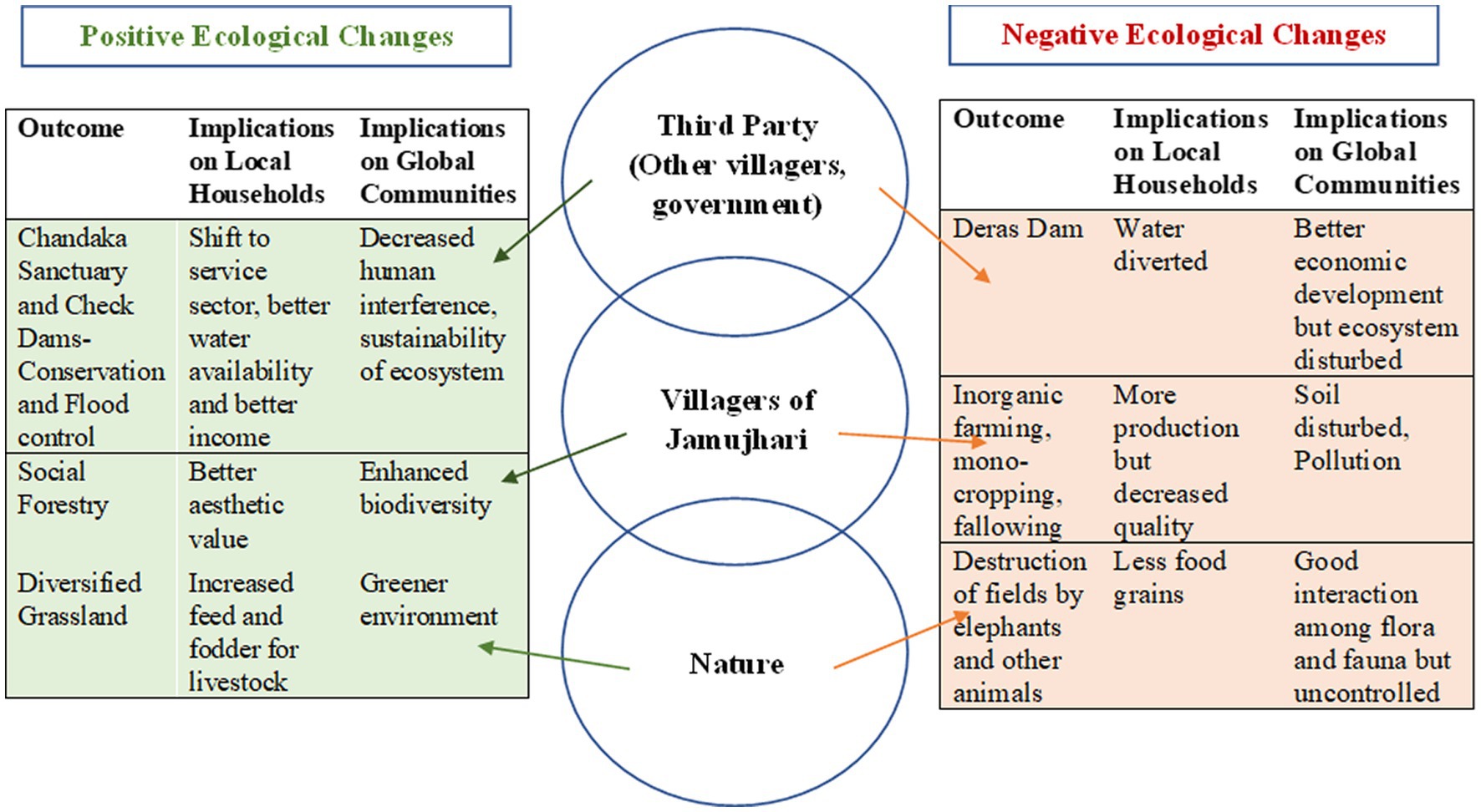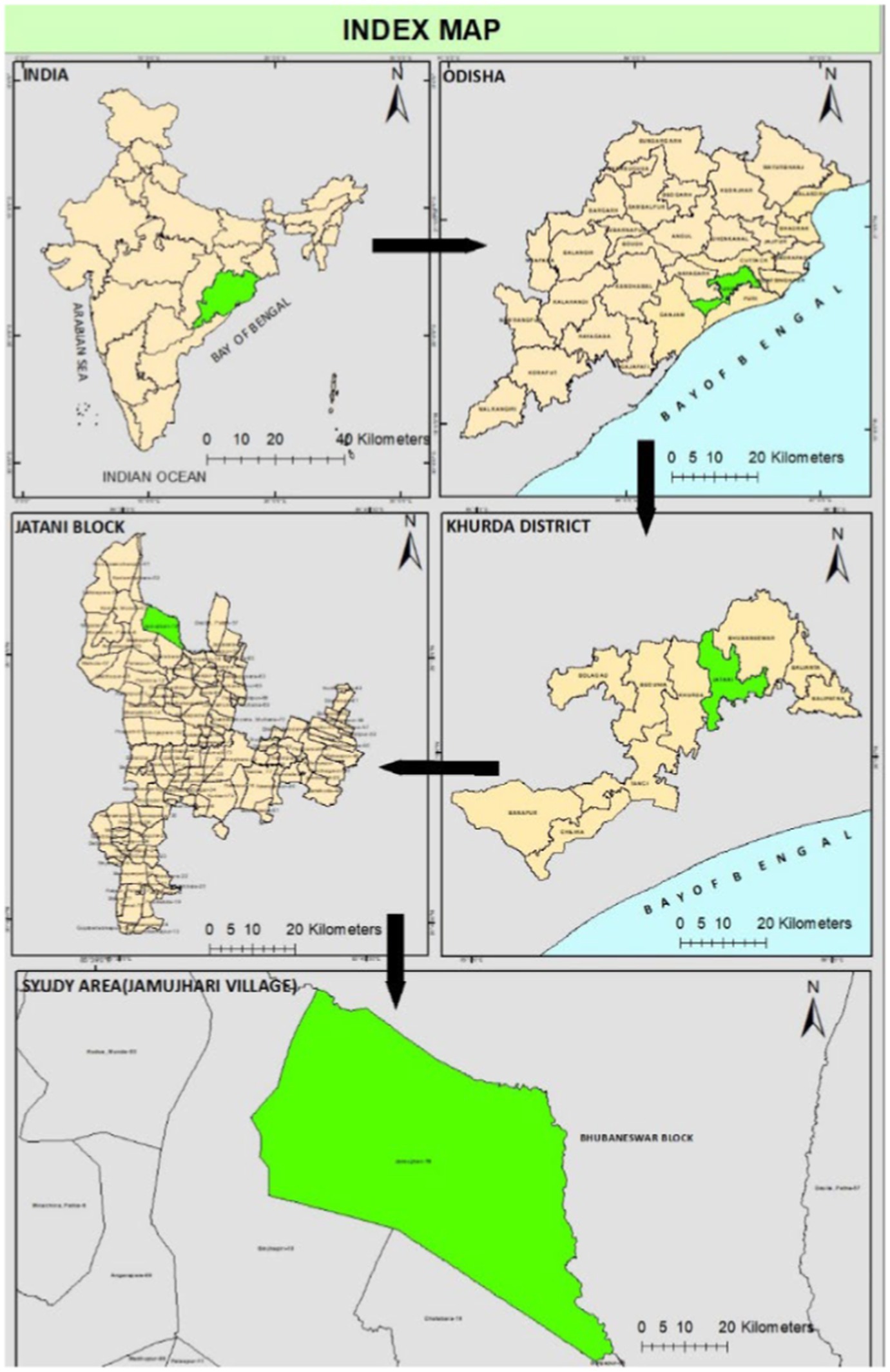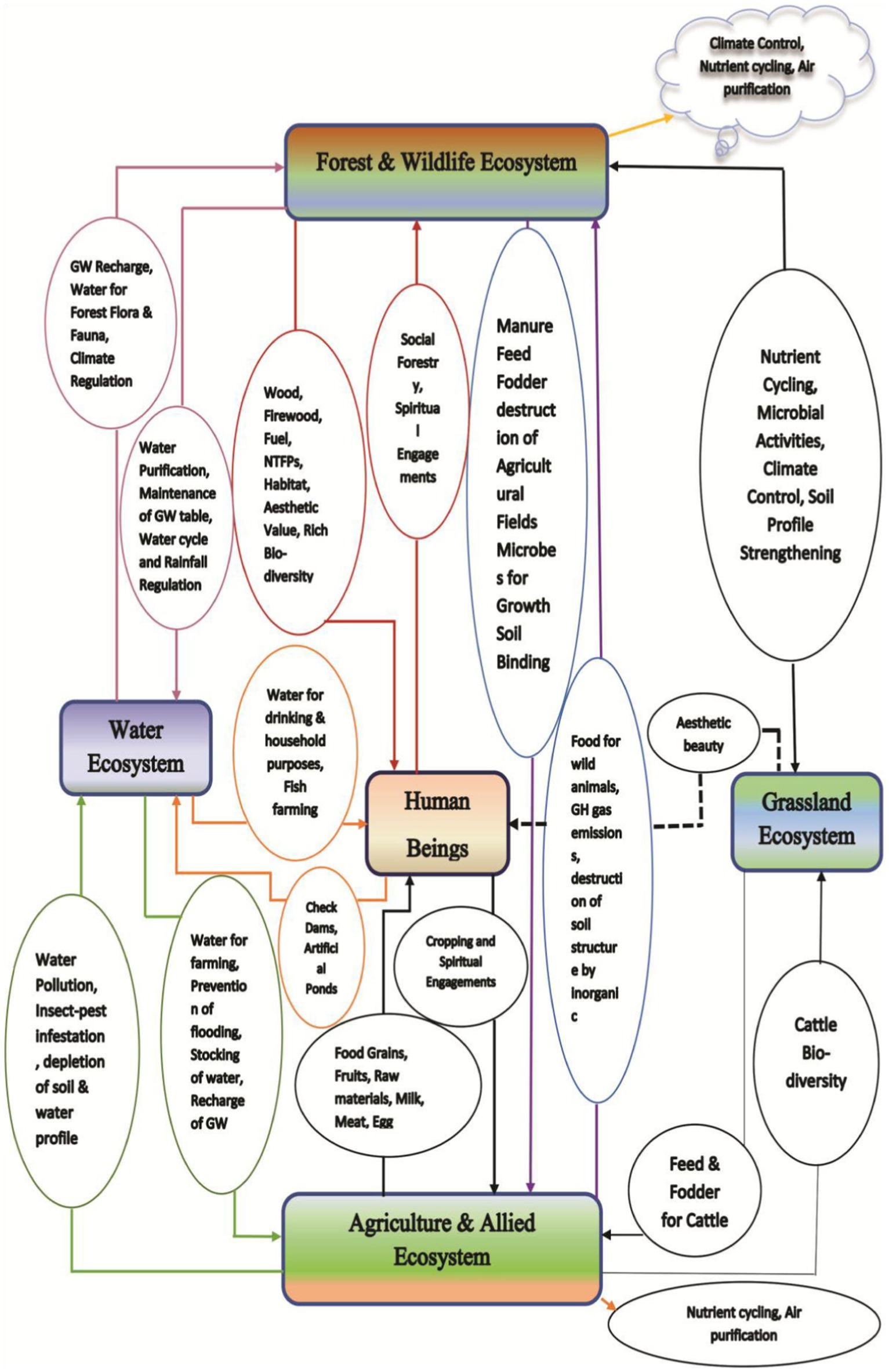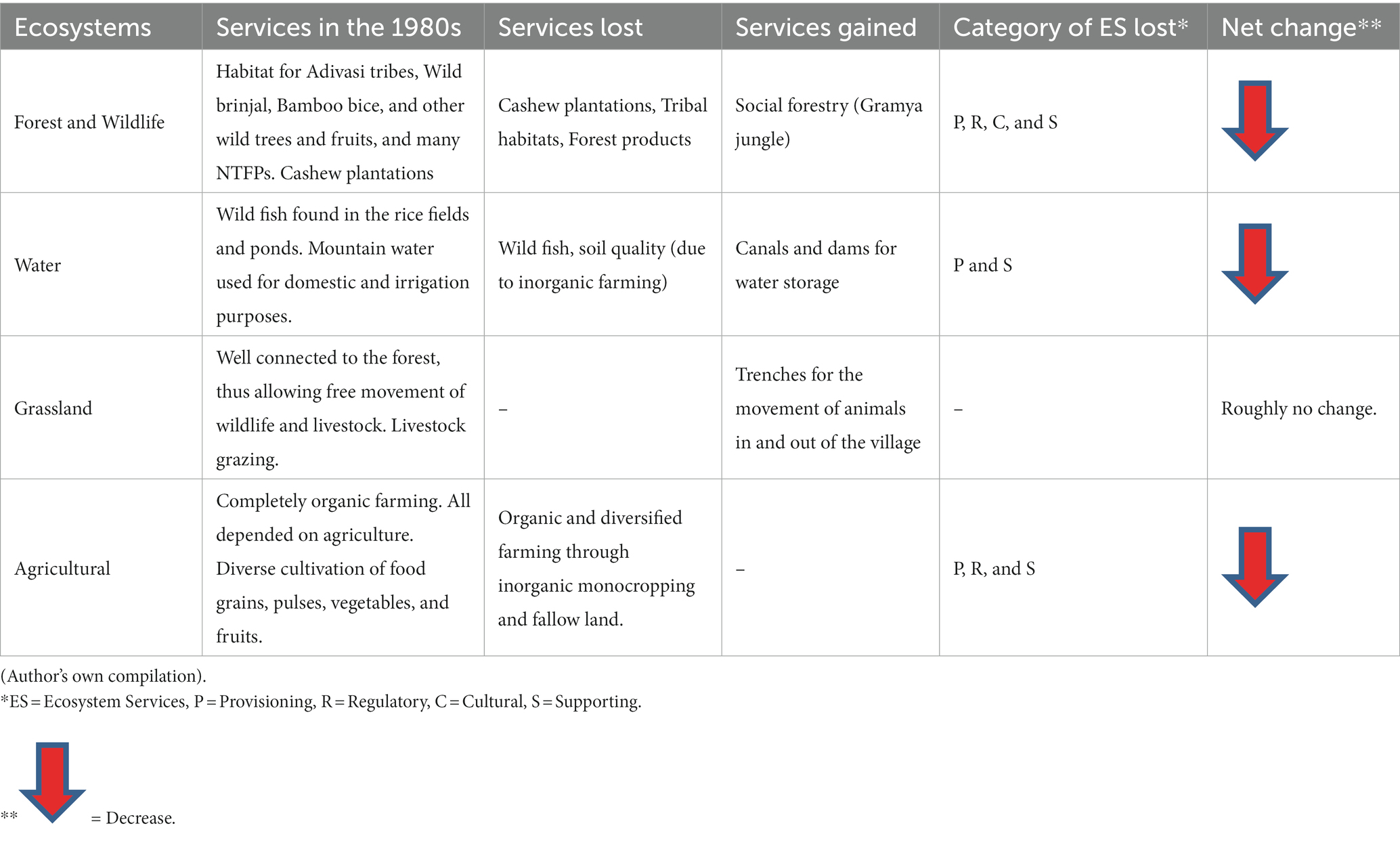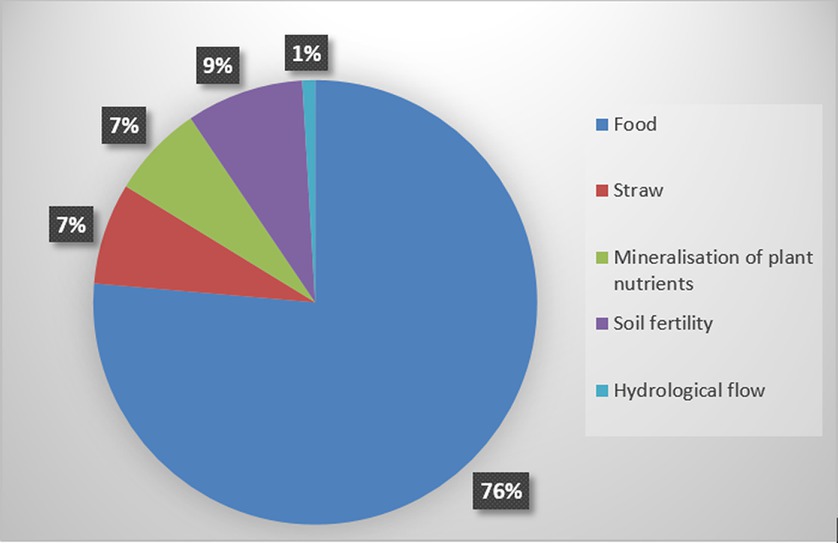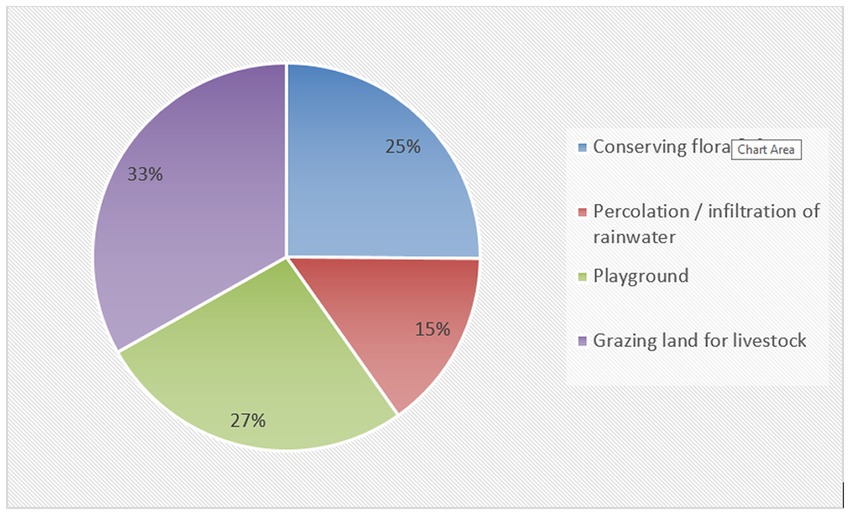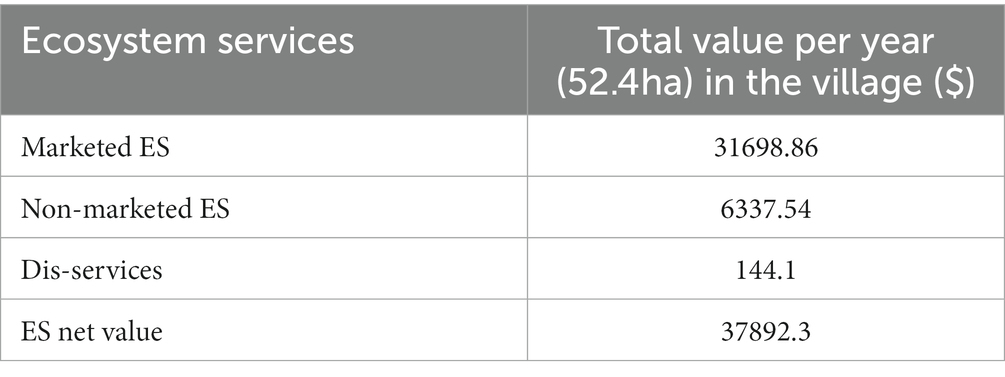- 1Department of Agricultural Economics, College of Agriculture, Odisha University of Agriculture and Technology, Bhubaneswar, Odisha, India
- 2School of Humanities and Social Sciences, National Institute of Science Education and Research, Bhubaneswar, India
- 3Homi Bhabha National Institute, Mumbai, India
- 4ICAR- National Institute of Agricultural Economics and Policy Research (NIAP), New Delhi, India
The study of ecosystem services (ES) has been gaining momentum for two main reasons-first to quantify the ES that the humans are enjoying; second, to incentivize the people or institutions that contribute to the improvement of ES. Agriculture, as the dominant form of land management, acts as both a provider and consumer of ES. The present study is an attempt to map the ecosystem services and assess the agricultural ecosystem services in the village landscape of eastern India. The study aims to understand the various ES, linkages, and trade-offs that have affected the welfare of households in an area of eastern India over time. We found that Jamujhari, the village investigated, had a diverse ecosystem that produced over 60 ecosystem goods, and provided over 200 ecosystem services to the villagers. Moreover, the village’s four ecosystems, viz., forest, water, grassland, and agricultural ecosystems, along with human resources, are integrated and interdependent. However, the ES and the dependence of households on nature’s services have undergone substantial changes over time. The valuation of agroecosystem services (paddy and fallow land ecosystems) was done using the benefit transfer method. The value of the ES for the rice ecosystem was estimated to be US $ 37892.3 year-1, while under fallow land it was US$ 9667.8 year-1. resulting in a total value of US $ 47560.1 year-1 of total agroecosystem services. We suggest comprehensive research to develop context-specific tools to identify and measure ES. Further, we recommend an appropriate policy mix by considering synergies and trade-offs among different ES.
1. Introduction
An ecosystem is a dynamic complex of flora, fauna, microbes, and their non-living environment that interact with each other to function as a unit (Sukhdev and Kumar, 2008). They produce goods and services that benefit human populations either directly or indirectly (Costanza et al., 1997). As per the United Nations Millennium Ecosystem Services Assessment (MA) of 2005, ecosystem services (ES) are the “benefits people get from the ecosystem” and are categorized into provisioning services, regulating services, cultural services, and supporting services (Millennium Ecosystem Assessment (MEA), 2005). Provisioning services include the direct benefits obtained from nature (which usually have a market value), such as food, water, and timber, while regulating services mainly refer to processes such as climate regulation, water purification, etc. Cultural services include the recreational, educational, asthetic, and spiritual benefits that humanity derives from the ecosystem, while supporting services are those that support the other three categories of ecosystem services through processes like soil formation and nutrient cycling (Daily, 1997). An economic valuation is a crucial tool for policymakers seeking to balance economic growth and the restoration of ecosystem services, particularly those that are not traded in real markets and are valued based on their social impacts (Gerowitt et al., 2003; Pagiola, 2008; Rasheed et al., 2021). Therefore, integrating economic valuation into decision-making processes enables policymakers to prioritize conservation efforts and promote sustainable development practices that preserve both economic and environmental benefits. However, since the valuation of ecosystem services faces many challenges, Costanza et al. mentioned in their paper (2017) that mapping all ecosystem services is in itself one of the most important ways to value them.
Agro-ecosystems are complex systems of climatic zones that include factors such as temperature, rainfall, and other parameters that influence crop growth through direct or indirect interactions with soil flora and fauna, like growth–promoting microbiota (Yadav et al., 2021). Unlike other ecosystems, agricultural ecosystems are largely driven by humans. They play a dual role by both providing and relying on ES (Garbach et al., 2014).
Agro-ecosystems comprise ecological and decision networks that are interdependent and interconnected, thus performing various functions that result in a wide range of ES. Furthermore, they are also connected at different levels of the landscape, which makes it difficult to manage their services (Tixier et al., 2013). Although most of the ES are valued and recognized by people, they do not have markets, leading to a lack of incentives to provide them that come with their prices (Swinton et al., 2007). Conservation and sustainable use of agricultural ecosystem services are crucial since these services ensure the well-being of both humanity and the environment. Therefore, it is necessary to balance the production of food with the preservation of ecosystem services to ensure long-term sustainability (Thrupp, 1998; Hajjar et al., 2008; Rasheed et al., 2021). Thus, knowing their intrinsic and economic value can help us promote greater investment for the sustainable management of agro-ecosystems (Rasheed et al., 2021).
The Food and Agriculture Organization (FAO) highlighted the importance of incentivizing rural communities to enhance the sustainability of agro-ecosystems and mitigate the effects of climate change. (How to feed the world in 2050 - Food and Agriculture Organization). In addition, assessing agroecosystem services can aid in developing appropriate payments for ecosystem services (PES) and eco-compensation schemes (naas.org.in). By providing financial incentives to rural communities, policymakers can encourage them to adopt sustainable land management practices. Attempts to value ecosystem services date back more than two decades and cover forests, wetlands, and agro-ecosystems in different regions of the world. However, when it comes to India, the evidence is not very promising. A few notable attempts at quantifying ecosystem services in India are “Value of a Tree” (1979) by Runko Luttenberger et al. (2018), the calculation of water supply benefits from the Almora forests by indirect methods by Chaturvedi in 1992 (Bisht, 2014), “The social distribution of provisioning forest ecosystem services: evidence and insights from Odisha, India” by Lakerveld et al. (2015), and “Assessment of ecosystem services of rice farms in eastern India” by Nayak et al. (2019).
India is an agrarian economy and is richly endowed with natural ecosystems that provide many services both locally and globally that still remain unrecognized and unvalued. Moreover, the conservationists (the rural masses and the farmers) are yet to be appreciated and rewarded for securing the services provided by agriculture. At present, the contribution of agriculture to the enhancement of ES is undervalued, thereby limiting the benefits to farmers. A study is therefore proposed to assess the value of the ecosystem services in a small geographical area. The present study will mainstream the value of natural agro-ecosystems in eastern India. Since Odisha is completely dependent on agriculture, especially rice, and is a low per capita income state (Odisha economic survey, 2021), it will provide good data on different rice ecosystems and the livelihood issues faced by the farmers. It will enhance knowledge of the existing ecosystems and the services they provide to society, facilitating greater local awareness and action to protect and improve the natural ecosystems. It will also play a pivotal role in strengthening the interaction and connection between humanity and nature, thus creating a green economy where the growth and health of our natural resources sustain each other. This study is an attempt to reflect the appropriate economic value of the natural environment and bring livelihood security for the poor (through PES) across eastern India. The study was undertaken with the objectives of classification and mapping of the ecosystems and their services, finding temporal changes in the ES in the last three decades, and evaluating agro-ecosystem services.
2. Materials and methods
2.1. Conceptual framework for changes in ecosystem services
Conceptual models have different roles, ranging from problem identification to the communication of complicated issues and the relationships between them. Essentially, they represent the cause-and-effect relationship (Dick et al., 2014). Some of the popular conceptual models that have been developed include the Pressure–State–Response (PSR) model used by the Organization for Economic Cooperation and Development (OECD) (OECD, 1991, 1993, 1996), the Stress-Response (SR) model (Rapport and Friend, 1979), and the Driver – Pressure – State –Impact – Response (DPSIR) framework of the European Environment Agency (EEA) (Smeets and Weterings, 1999).
The framework in this study (Figure 1) is developed based on the analysis of the changes that have taken place over time in the village of Jamujhari by various agents such as nature, villagers, and government agencies. Since any change in the existing ecosystem is the outcome of a positive or negative drive, care has been taken to conceptualize the impact of both positive and negative changes on the welfare of the local and global environment. This framework is essentially qualitative and may help us draw significant conclusions about similar changes in other areas where ecosystems and their uses have been altered by their drivers of change, i.e., either naturally or by human interference.
2.2. Data and research design
Considering the proposed study, both primary and secondary data (years 2020–21) were used to achieve the proposed objectives. Primary data were collected for various ecosystems and their services, willingness to pay for these, and temporal changes in the ecosystems over four decades. Secondary data were collected for land use, land cover, indicators, conversion factors, and values of ecosystem services from other studies. Primary data was collected through focus group discussions (Hennink, 2013), expert interviews, and the Delphi technique (Goodman, 1987). A total of 50 farm households and 20 experts from Jamujhari, Khurda were interviewed. Household surveys provided information on the individual ecosystem services enjoyed by the villagers. FGDs were conducted to collect information on the status of common property resources in the village. Information on the common ecosystem services and willingness to pay for agro-ecosystem services was obtained through the FGDs. Expert interviews involved interaction with the current and former village sarpanch, village elders, cooperative society members, agri-dealers, and gramya committee members. They provided information about the temporal changes in the ecosystem and the ecosystem services over four decade. They were also interviewed about their willingness to pay for the agro-ecosystem services available in the village. The Chandaka-Dampara sanctuary, renowned for its beauty and pristine habitat for many species, is a success story. Spread over an area of 193.39 sq.km on the uplands of the northeastern Ghats of the biotic region, the Chandaka-Dampara Sanctuary is a rich trove of biodiversity. Bordering this biodiversity hotspot is the village of Jamujhari, which also provides ecological services to its inhabitants. However, with rapid urbanization and the demarcation of the Chandaka forest boundaries, the village has been neglected for the ecosystems and their services that they render. The village can serve as a perfect hub for both the ecological and economic sustainability of the local population as it is rich in ecosystems such as water, forest, grassland, and agricultural. Therefore, this hamlet was purposefully selected as the study area to determine the economic value of the ecosystem services found in and around it. The location of the study area is presented in Figure 2. Secondary data regarding land patterns, demographic details of the village, area, production, and yield were collected from the local authorities and official state census data. Satellite map data on land use and cover were also used. Data from appropriate literature reviews and meta-analyses of previous studies were used for validation. The study was conducted in eastern India, more specifically in the state of Odisha, close to the famous Chandaka forest, a global hub for biodiversity. Potential data sources were the Odisha Space Applications Centre, the district agriculture officers, agricultural statistics, and finally workers, households, and farmers at the village level.
2.3. Valuation of agro-ecosystem services
This objective purely deals with the valuation of ecosystem services from the agricultural ecosystem in the village. It was found that only kharif rice was cultivated in the study area, while the rest of the agricultural land was completely fallow. Thus, the valuation was divided into two parts – one being the valuation of the kharif paddy and the other being the fallow land. The valuation of paddy was done using the benefit transfer method from the paper by Nayak et al. (2019), while the ecosystem services of fallow land were evaluated using the open-ended contingent valuation method.
2.3.1. Valuation of paddy ecosystem services
Various conversion factors and indicators were used in the valuation of paddy ecosystem services. The coefficients from the paper by Nayak et al. (2019) used in the assessment were modified for inflation, and the area was multiplied by the adjusted factors to determine the economic values.
The gross value of rice ecosystem services was calculated by adding the values of provisioning, regulatory, and supporting services. The net value of the services was found by subtracting the value of dis-services from the gross value. Cultural services could not be calculated due to time and reliability limitations.
2.3.1.1. Provisioning services
These are the goods and services from the ecosystem that provide direct benefits and have a definite market value (Rasheed et al., 2021). Grain and straw were calculated using the market price method.
2.3.1.2. Regulatory services and supporting services
Regulatory services are those that are derived from the regulation of the ecosystem, while supporting services are the ones that help in the proper working of the other components of the ecosystem (Rasheed et al., 2021). These include non-marketed goods and services, with components such as pest control, nutrient cycling, soil formation, and so on. The benefit transfer method (Johnston et al., 2015) was used to calculate the values of the regulatory and supporting services. The services from previously existing studies are compared with the services of the present study, along with the similarities in the location and ecosystem of the studies (Byrne, 2022). If the services are found to be similar, then the values from the other locations are transferred to the current study. Values from the 2019 analysis by Nayak et al. were taken and adjusted in the context of our studies as follows:
The mean value of the non-marketed goods from review = y $.
Adjusted mean value = (y/WPI) * 100 = w.
The total value of non-marketed goods = w * total area of the present study (ha) = z $.
Note: WPI for 2020–21 = 163.5 (Source: GOI Office of Economic Advisor).
2.3.1.3. Dis-services
Paddy has a direct effect on the soil and is a major emitter of greenhouse gasses like methane, carbon dioxide, and nitrous oxide (Kumar et al., 2016). Carbon emissions and soil erosion are calculated in this study. To calculate the dis-service caused by carbon, the mean carbon emission value has been taken and multiplied by the total area. The benefit transfer method was used again for both dis-services.
2.3.1.4. Calculation of net paddy ecosystem services
where ESTP = total ES value from the paddy ecosystem, ESM = marketed (tangible) ES values, ESNM = non-marketed (non-tangible) ES values, and EDS = value of dis-services. ES = Ecosystem Services, EDS = Ecosystem Dis-services.
2.3.2. Valuation of fallow land ecosystem services
The willingness to pay of the locals was estimated using the open openended contingent valuation method (Bishop and Heberlein, 2019). The locals were explained about the services and dis-services of the fallow land ecosystem, and about the need to conserve the ecosystem to maximize the economic benefits derived from it. A hypothetical situation was then created in which people were organized into groups and asked about their willingness to pay for saving the fallow land or preventing it from being converted into construction sites. The average willingness to pay per unit area was calculated and then multiplied by the total area to find out the value of the ecosystem services provided by the fallow land.
Willingness to pay for a given ES by individuals (per ha) = W1, W2, W3 …… WN US$.
Total number of respondents = N.
Average willingness to pay by all respondents for a given ES (per ha) = ∑Wi / N US$ = WA.
Total willingness to pay by all respondents for a given ES (per ha) = WA* Total area of fallow land = WT1.
Similarly, the values for all the ES from the fallow land were computed and added.
Total ES from fallow land = WT1 + WT2 + WT3 …………. + WTN.
The dis-services were then subtracted and the net value was found.
Net ESF = Net Ecosystem Services from Fallow Land.
2.3.3. Classification and mapping of ecosystem services
After the FGDs and expert interviews, data on ecosystem goods and services found in the village of Jamujhari were collected. The data was then presented in tabular form and classified according to the ecosystem classification systems used worldwide, i.e., the Millennium Ecosystem Assessment (MEA) (2005), The Economics of Ecosystems and Biodiversity (TEEB) (2011), Costanza et al. (2017), and the Common International Classification of Ecosystem Services (CICES) (Millennium Ecosystem Assessment (MEA), 2005; The Economics of Ecosystems and Biodiversity (TEEB), 2011; Costanza et al., 2017; Structure of cices, 2022).
2.3.4. Temporal changes in ecosystem services
The second objective of the study was to find out the changes in ecosystem services benefiting the village in the past four decades (1985) and in the present time. The data pertaining to this objective was collected using the above-mentioned tools, i.e., FGDs, expert interviews, and the Delphi technique using multiple rounds of questions. These data were mostly based on interviews with the elders of the village, who had a detailed idea about the changes that had taken place in the village in the last four decades. Secondary sources of data in the form of satellite maps were also used for this analysis from Google Maps (Google earth, 2023). After collecting the data, these were presented in the form of a table indicating the increase, decrease, or consistency of the ecosystem services related to the village. The conceptual framework mentioned in Figure 2 was used for a qualitative analysis based on the perception and memory of the participating villagers and the maps available. Subsequently, a comparative analysis between the two time periods was compiled in tabular form, thus completing the second objective of the study.
3. Results
3.1. Mapping and classification of ecosystem services
The study area is situated near the Chandaka Wildlife Sanctuary, and it has well-connected and diverse ecosystems. This region in eastern India is a hub of biodiversity that promotes four major ecosystems, such as forest, water, grassland, and agricultural. All the ecosystems have been providing the residents with innumerable direct and indirect benefits. There are roughly 64 ecosystem goods derived from these ecosystems, which provide over 200 ecosystem services to the villagers (Annexure I–Supplementary material). As per the various classification systems and cascade setting framework, the ecosystem services of the village were classified into four major categories: Provisioning services, Regulatory services, Cultural services, and Supporting services.
The people derived numerous direct benefits from their ecosystems, the most important of which were food grains like rice, firewood from trees like acacia and neem, food and dry fruits from the forest like amla, cashew, and other NTFPs like honey, wild mushrooms, etc. They also got feed and fodder for their livestock from the grasslands. The water ecosystem consisted of ponds, natural dams, and natural wells (Annexure I–Supplementary material), which not only provided villagers with drinking water and water for irrigation but were also a source of aquatic flora, fauna, and fish. The natural dams also aided in stocking water and preventing floods. In addition, locals also got milk and meat from the livestock, which contributed both to their diet and to their economic livelihood. Moreover, the indirect services provided by the ecosystems were much greater than the direct benefits obtained. From the rich fauna population to the lush greenery, the region provided asthetic beauty and satisfaction to its inhabitants, along with places of spiritual relevance (like the temple in the mountain) that have kept the ancient traditions that are still alive in the present generation. Nevertheless, with such an abundance of natural resources, the climate and soil have constantly been regulated, even with a large number of anthropogenic effects like excessive inorganic farming.
However, as mentioned above, it is important to understand that no single ecosystem can ever exist on its own without support from nearby ecosystems. Specifically, the agricultural ecosystem is one such system that derives its existence from other ecosystems, such as the water and forest ecosystems, which provide raw materials for its sustenance. In return, the agricultural ecosystem also helps to strengthen the soil structure through its roots and other microbial activities. Not only that, but the services also come with certain dis-services that are equally shared by all ecosystems. For example, rice ecosystems release methane, which is harmful to the environment as a whole. Thus, the release of this greenhouse gas ultimately affects both humans and all other ecosystems in the village.
Humanity is also an integral part of the ecosystem. Neglecting its contribution and dis-contribution to nature can also lead to an underestimation of the entire process taking place in the area investigated. Many anthropogenic activities have negative effects on the environment. However, certain good practices, such as social forestry, the creation of check dams, ponds, and wells, and the practice of agriculture, have positive implications for the maintenance of ecological balance.
Therefore, it can be said that forest, water, grassland, and agricultural ecosystems, together with human resources, form an integrated, complex system. These ecosystems are interdependent for their survival and maintenance, thus creating ecological sustainability. This interlinkage in the context of Jamujhari village is well displayed in Figure 3, thus successfully achieving the first objective of this study.
3.2. Temporal changes in ecosystem services over the last four decades
The study area has been subjected to the effects of urbanization and many development projects. As the area is in close proximity to the Chandaka forest, residents relied on it for their day-to-day sustenance and livelihood, greatly benefiting from it. A group of tribes also lived in the forests and depended on that ecosystem for their survival. However, with the creation of the Chandaka Elephant Sanctuary in 1982, residents were restricted in their interaction with the forest ecosystem. Also, with the establishment of the Deras Farm, much of the water resources were diverted for use on the horticultural projects by the state and the ICAR, thus depriving the villagers of their previous usage. Moreover, much of the effect of urbanization was observed on the livelihoods of those who moved from agriculture to the service industry. Also, agriculture turned completely inorganic and mechanized, which had an impact on wild fish production and destroyed the soil profile. Detailed changes in ecosystem services between 1982 and 2020 can be seen in Table 1.
From Table 1, it is clear that in the last four decades or so, there has been a severe decrease in the ecosystem services used by the villagers as a result of the creation of the boundary of the Chandaka forest sanctuary, especially with the development of the Deras Farm, which has diverted most of the natural resources to them. As locals were heavily dependent on the forest and its natural resources for their daily lives, they never realized the indiscriminate use of the existing resources within the village boundaries. Thus, with the restrictions on the use of forest and water resources, there were quite a few efforts made by the residents to restore their ecosystems by re-creating a small forest in the village (social forestry) and by building a few ponds and dams in order to store water for their personal and agricultural use. However, they lost many of the benefits that they used to derive, mainly from the cashew plantations and from the wild vegetables and NTFPs in the forest ecosystem. Moreover, the tribes were the most affected, as they were displaced from their natural habitat and way of life. This also led to a decline in involvement in agriculture. As stated above, the majority of agricultural lands were removed for various building projects as a result of urbanization. As the residents have shifted to the service sector, the rest of the village’s agricultural land has either been left fallow or subjected to monocropping of rice, leading to many ecological imbalances in and around the village environment (such as the release of methane, insect/pest infestation, and destruction of the soil profile). So, we can clearly say that during these years the village has been subjected to severe disturbances in terms of its ecology, thereby reducing the services and increasing the dis-services of the existing ecosystems. Moreover, there has also been a change in rice cultivation, from local varieties to high-yielding varieties. Annexures II and III (Supplementary material) show the details of the varieties used both in the past and present.
There was a shift in the use of the rice varieties (Annexures II and III–Supplementary material). The most important change seen is the abandonment of the Swarna Masoori rice variety. Despite its sturdy nature and high yield, the variety was banned due to its high susceptibility to pests and diseases. Moreover, owing to its higher yield, the villagers have switched over to the HYV rather than using indigenous varieties. These are still somehow used by a few small and marginal farmers for domestic use and seed production. However, the use of HYV has made agriculture completely intensive and inorganic, which has had a negative impact on the soil and agrobiodiversity. The agricultural ecosystem is interdependent on other ecosystems, such as forest, water, and grassland. The compartmentalization of various ecosystems and their management has had detrimental effects on the overall ecosystem. Alienation of local tribes from the forest ecosystem has intensified unsustainable agricultural practices. Occupational mobility of the farmers from agriculture to the service industry has also caused sub-optimal use of the agro-ecosystem.
3.3. Valuation of agricultural ecosystem services
3.3.1. Valuation of rice ecosystem services
It is clear that provisioning services (food and straw) constitute a major part of the rice ecosystem, followed by soil fertility and the mineralization of nutrients (Figure 4). The highest share of provisioning services shows that the agriculture in the village is completely intensive and used for commercial purposes, and due to the damaged agro-ecosystem, the flow of other services has been affected, making their values significantly lower than those of provisioning services.
3.3.2. Valuation of fallow land ecosystem services
As compared to the rice ecosystem, the fallow land ecosystem has a more balanced distribution of ecosystem services, with grazing land contributing the most (33%) (Figure 5).
The value of marketed services from rice ecosystems is US$ 31698.86 per year, and that of non-marketed services is US$ 6337.54 per year. Thus, the net value of rice ecosystem services is US$ 37892.3 per year (Table 2). Fallow land provides ecosystem services worth $ 9667.8 per year (Table 3). Therefore, the total economic value of the agricultural ecosystem services in the study area amounts to $ 47560.1 per year. However, this study did not measure the value of cultural ecosystem service. Consequently, the actual value of ecosystem services may be higher than the estimated value in this study.
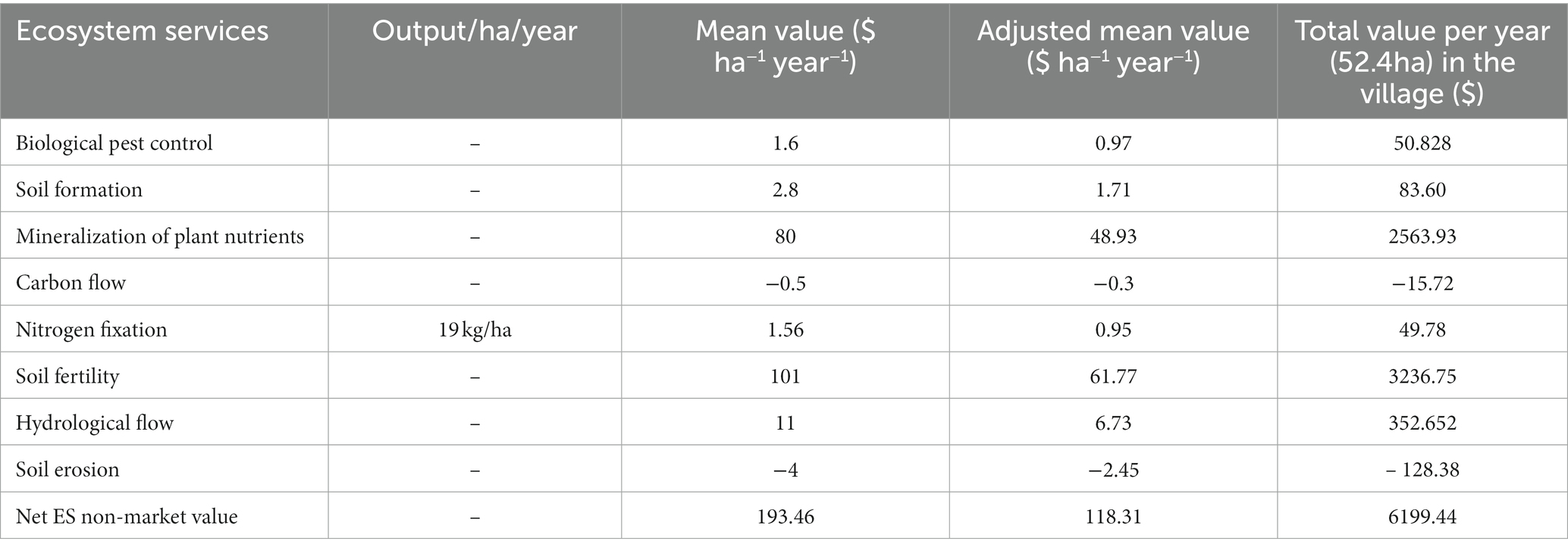
Table 3. Value of regulatory and supporting services and dis-services provided by the rice ecosystem.
4. Discussion
4.1. Ecosystem services
The results indicate the presence of over 200 ecosystem services in a micro-environment. This shows the importance of a group of interconnected ecosystems for a sustainable future. In line with other studies, this paper also emphasizes that humanity is deeply dependent on natural capital and well-functioning ecosystems, which are the basis for the continuous flow of ecosystem services to society as a whole (Burkhard and Maes, 2017). The study also found that regulating and supporting services were the most common and abundantly available, a result that is also consistent with other studies (Egoh et al., 2012; Martínez-Harms and Balvanera, 2012). The comparison between the land uses from different ecosystems showed a lower number of ecosystem services from agricultural land (Malinga et al., 2015). A major finding, however, was that all ecosystems, particularly agricultural ecosystems, are inter-dependent, with humans being the central link between all of them. Interestingly, cultural services were found to be an integral part of the agricultural and forest ecosystems, indicating a close relationship between nature and culture (Beilin et al., 2014).
4.2. Temporal changes
Over the years, there has been a decline in the services perceived by people, especially in the agricultural ecosystem. This is probably due to the shift away from and neglect of agriculture. Agriculture as a multifunctional ecosystem (Foley et al., 2005) faces conflicting interests between ecosystem service trade-offs (Bennett et al., 2009; Power, 2010; Smith et al., 2012).
Despite the lack of benefits from the previously used ecosystem services, people are now better off in terms of standard of living and infrastructure. They have playgrounds, schools, community centers, and most importantly, Pakka houses, and are hardly dependent on the natural resources of the village for their daily living. However, it is also important to note that with the intervention of third parties and more awareness toward the conservation of biodiversity, major steps have been taken by various governments and private organizations (or partnerships) for the creation of farms and the definition of forest boundaries. In addition, various water conservation projects have also been taken up to divert water resources for human use while also preventing flooding in nearby areas. Residents have also been engaged in the preservation of the existing natural resources in the study area and have created small vegetable gardens in each household. The grassland area has remained undisturbed and has developed over the years. However, the dependence of the locals on the ecosystem has decreased significantly. As stated above, the residents’ socio-economic welfare has also increased due to better education and employment opportunities in the service industry owing to their proximity to the city. Nevertheless, the macro-environment has benefited to a greater extent with less human intervention.
One of the major negative impacts on the ecosystem has been observed due to the shift in rice varieties from local types to high-yielding varieties (HYV). The local varieties used in the past were sturdy, has better adaptability, and were less intensive in terms of fertilizer and pesticide use. The plant population was also smaller. All of this contributed to more environmentally sustainable agriculture. However, with the use of HYV, although there was a substantial increase in yield, these were found to be very input-intensive, and the area became completely dominated by inorganic agriculture, with rice HYV contributing to the pollution and degradation of the soil owing to the excessive use of inorganic fertilizers and pesticides. Also, as a result of intensive agriculture, the plant population of HYV is quite high, leading to more carbon and methane emissions, which badly pollute the environment. Another important change was seen in the use of rice straw as fodder for livestock. Desi types and local varieties served as better and healthier feed for animals as compared to the HYV, thus the shift has also resulted in a decrease in the availability of quality fodder. Therefore, we can clearly see that the agricultural ecosystem has undergone a negative ecological change over the years. Studies from other countries have also concluded that urbanization, industrialization, and changes in agricultural production patterns are the main factors in the deterioration of environmental quality and have proven to be a major threat to biodiversity (Su et al., 2013, 2018).
Thus, using the conceptual framework developed (Figure 1) and the perceptions of the respondents, we can conclude that there has been an overall increase in global ecological welfare as a result of better conservation of forest, grassland, and water resources. However, in agriculture, there has been a negative impact on the macro-environment as a result of excessive inorganic farming in addition to fallow land for years, together with a complete shift in the use of rice varieties. However, looking at the local household, we can say that there has been an overall increase in economic welfare despite the unavailability of most of the previously used ecosystem services, due to the shift from local dependence to the service industry and to mechanized and inorganic farming that yields better output for marketable purposes.
4.3. Economic value of agro-ecosystem services
From the valuation of the agro-ecosystem services (Tables 4–7), it is clear that despite the neglect of agriculture, the services render a good amount of economic benefit, which can be used as a tool to incentivize and design appropriate payments for ecosystem services. The results are similar to those of Nayak et al. (2019). The results of this study are also consistent with a recent study by Das et al. (2022). The study suggests that provisioning services have the greatest importance and that tribal communities are the most important and vulnerable groups for the sustainability of both ecosystem services and livelihood security. The study also shows that high priority must be given to cultural, supporting, and regulatory services because of their potential to generate provisioning services in addition to providing economic benefits.

Table 5. Value of provisioning, regulatory, and supporting services provided by the fallow land ecosystem.
5. Conclusion
The present study was an attempt to mainstream the awareness of the present generation toward a sustainable economy-environment interaction. Our findings clearly show the variety of services provided by a micro-ecosystem. The study area supported over 200 ecosystem services from all four ecosystems, viz., forest, water, agricultural, and grassland. Over the years, there has been a shift in the dependence and conservation of ecosystems and their services due to urbanization, government interventions, and transitions from the agricultural sector. Most of the ecosystems have been subject to a decrease in their services, as perceived by the residents. However, due to conservation strategies, the forest ecosystem has been less exploited, giving way to greater ecological welfare. Conversely, the agricultural ecosystem was found to be the most affected because of repeated monocropping and fallow land. Moreover, the shift to the service industry had led to complete neglect of the agricultural lands in the region. Despite all of the above, the agricultural ecosystem has provided a large number of ecosystem services worth $ 47560.1 annually. The value of ecosystem services from agriculture clearly indicated the need to incentivize conservationists and develop some sort of eco-compensation or (Payment for ecosystem services–naas, 2022) by the government for a sustainable future. As ecosystem services have the potential to become an important policy and decision-making tool at all scales, possible applications and implementations must be made for sustainable management of natural resources along with economic inclusion for livelihood security. These kinds of studies can be replicated in various regions by making quantification and valuation of ES mandatory in different government programs such as natural farming, organic farming, and so on. Also, incentivizing farmers to use payments for ecosystem services programs can help in the effective transfer of benefits to farmers. Strengthening technology transfer and extension services, integrating ES by using a system-wide approach in decision-making and national agricultural policies, comprehensive research work to design context-specific tools for identifying and measuring ES, and designing appropriate policy mix by including synergies and trade-offs among different ES are some of the policy suggestions that can be implemented for valuing the ES and designing payments for ES within the country and globally.
Data availability statement
The original contributions presented in the study are included in the article/Supplementary material, further inquiries can be directed to the corresponding author.
Author contributions
SR, AD, TK, and KS: conceptualization and formal analysis. SR, AD, and TK: methodology and visualization. AD, TK, and KS: validation and supervision. SR and TK: data curation. SR: writing—original draft preparation and writing—review and editing. All authors have read and approved the version of the manuscript that was submitted for publication.
Acknowledgments
This paper was a part of the master’s thesis of Miss Suvangi Rath done in the Department of Agricultural Economics, College of Agriculture, OUAT, Bhubaneswar.
Conflict of interest
The authors declare that the research was conducted in the absence of any commercial or financial relationships that could be construed as a potential conflict of interest.
Publisher’s note
All claims expressed in this article are solely those of the authors and do not necessarily represent those of their affiliated organizations, or those of the publisher, the editors and the reviewers. Any product that may be evaluated in this article, or claim that may be made by its manufacturer, is not guaranteed or endorsed by the publisher.
Supplementary material
The Supplementary material for this article can be found online at: https://www.frontiersin.org/articles/10.3389/fsufs.2023.1151205/full#supplementary-material
References
Beilin, R., Lindborg, R., Stenseke, M., Pereira, H. M., Llausàs, A., Slätmo, E., et al. (2014). Analysing how drivers of agricultural land abandonment affect biodiversity and cultural landscapes using case studies from Scandinavia, Iberia and Oceania. Land Use Policy 36, 60–72. doi: 10.1016/j.landusepol.2013.07.003
Bennett, E. M., Peterson, G. D., and Gordon, L. J. (2009). Understanding relationships among multiple ecosystem services: relationships among multiple ecosystem services. Ecol. Lett. 12, 1394–1404. doi: 10.1111/j.1461-0248.2009.01387.x
Bishop, R. C., and Heberlein, T. A. (2019). “The contingent valuation method” in Economic valuation of natural resources. eds, Rebecca L Johnson and Gary V. Johnson (London: Routledge)
Bisht, N. S. (2014). Economic valuation of the role of forests in providing water supply to the people of Kohima town, Nagaland, India. Saarc Forestry J. III:47.
Burkhard, B., and Maes, J. (2017). Mapping ecosystem services. Adv. Books 1:e12837. doi: 10.3897/ab.e12837
Byrne, M. (2022). Benefit transfer method. Available at: https://www.ecosystemvaluation.org/benefit_transfer.htm (accessed: 20 December, 2022).
Costanza, R., d’Arge, R., de Groot, R., Farber, S., Grasso, M., Hannon, B., et al. (1997). The value of the world’s ecosystem services and natural capital. Nature 387, 253–260. doi: 10.1038/387253a0
Costanza, R., de Groot, R., Braat, L., Kubiszewski, I., Fioramonti, L., Sutton, P., et al. (2017). Twenty years of ecosystem services: how far have we come and how far do we still need to go? Ecosyst. Serv. 28, 1–16. doi: 10.1016/j.ecoser.2017.09.008
Daily, G.C. (1997) Nature’s services: Societal dependence on natural ecosystems. Washington, DC: Island Press.
Das, M., Das, A., and Pandey, R. (2022). Importance-performance analysis of ecosystem services in tribal communities of the Barind region, eastern India. Ecosyst. Serv. 55:101431. doi: 10.1016/j.ecoser.2022.101431
Dick, J., Smith, R., Banin, L., and Reis, S. (2014). Ecosystem service indicators: data sources and conceptual frameworks for sustainable management. Sustain. Acc. Manag. Policy J. 5, 346–375. doi: 10.1108/SAMPJ-11-2013-0051
Egoh, B., Drakou, E.G., Dunbar, M.B., Maes, J., and Willemen, L. (2012). Indicators for mapping ecosystem services: a review Ispra, Italy: European Commission, Joint Research Centre (JRC).
Foley, J. A., DeFries, R., Asner, G. P., Barford, C., Bonan, G., Carpenter, S. R., et al. (2005). Global consequences of land use. Science 309, 570–574. doi: 10.1126/science.1111772
Garbach, K., Milder, J. C., Montenegro, M., Karp, D. S., and De Clerck, F. A. J. (2014). Biodiversity and ecosystem services in agro-ecosystems. Encycl. Agric. Food Syst. 2, 21–40. doi: 10.1016/B978-0-444-52512-3.00013-9
Gerowitt, B., Isselstein, J., and Marggraf, R. (2003). Rewards for ecological goods—requirements and perspectives for agricultural land use. Agric. Ecosyst. Environ. 98, 541–547. doi: 10.1016/S0167-8809(03)00112-9
Goi Office of economic adviser. (2023). Available at: https://eaindustry.nic.in/ (Accessed: April 28, 2023).
Goodman, C. M. (1987). The Delphi technique: a critique. J. Adv. Nurs. 12, 729–734. doi: 10.1111/j.1365-2648.1987.tb01376.x
Google earth. (2023). Google. Available at: https://earth.google.com/web/@0 (accessed: January 15, 2023).
Hajjar, R., Jarvis, D. I., and Gemmill-Herren, B. (2008). The utility of crop genetic diversity in maintaining ecosystem services. Agric. Ecosyst. Environ. 123, 261–270. doi: 10.1016/j.agee.2007.08.003
How to feed the world in 2050 - food and agriculture organization. (2022). Available at: https://www.fao.org/fileadmin/templates/wsfs/docs/expert_paper/How_to_Feed_the_World_in_2050.pdf (accessed: December 19, 2022).
Johnston, R. J., Rolfe, J., Rosenberger, R. S., and Brouwer, R. (2015). Benefit transfer of environmental and resource values. Econ. Non Mark. Goods Resour. 14, 19–29. doi: 10.1007/978-94-017-9930-0
Kumar, A., Nayak, A., Mohanty, S., and Das, B. (2016). Greenhouse gas emission from direct seeded paddy fields under different soil water potentials in eastern India. Agric. Ecosyst. Environ. 228, 111–123. Available at:. doi: 10.1016/j.agee.2016.05.007
Lakerveld, R. P., Lele, S., Crane, T. A., Fortuin, K. P. J., and Springate-Baginski, O. (2015). The social distribution of provisioning forest ecosystem services: evidence and insights from Odisha India. Ecosyst. Serv. 14, 56–66. doi: 10.1016/j.ecoser.2015.04.001
Mala, M., Jahan, M., and Islam, K. S. (2009). Comparative prey consumption of a predatory spider, Pardosa pseudoannulata (bosenberg and strand) on three different diets. Progress. Agric. 20, 57–62. doi: 10.3329/pa.v20i1-2.16850
Malinga, R., Gordon, L. J., Jewitt, G., and Lindborg, R. (2015). Mapping ecosystem services across scales and continents – a review. Ecosyst. Serv. 13, 57–63. doi: 10.1016/j.ecoser.2015.01.006
Martínez-Harms, M. J., and Balvanera, P. (2012). Methods for mapping ecosystem service supply: a review. Int. J. Biodiv. Sci. Ecosyst. Serv. Manag. 8, 17–25. doi: 10.1080/21513732.2012.663792
Millennium Ecosystem Assessment (MEA) (2005). Ecosystems and human well-being: Synthesis. Washington, DC: Island Press.
Nayak, A. K., Shahid, M., Nayak, A. D., Dhal, B., Moharana, K. C., Mondal, B., et al. (2019). Assessment of ecosystem services of rice farms in eastern India. Ecol. Process. 8, 1–16. doi: 10.1186/s13717-019-0189-1
Odisha economic survey (2021). Finance department. Available at: https://finance.odisha.gov.in/news/odisha-economic-survey-2020-21 (accessed: March 17, 2021).
OECD (1991). Environmental indicators. a preliminary set. Paris: OECD Publications and Information Center.
OECD. (1993). OECD core set of indicators for the environmental performance reviews. Environment Monographs No. 83 Paris, France: Organisation for Economic Cooperation and Development.
OECD. (1996). Developing OECD Agri-environmental indicators. Mimeograph. July 30. Paris, France: Organization for Economic Cooperation and Development.
Pagiola, S. (2008). How useful is ecosystem valuation. Economics and conservation in the tropics: a strategic dialogue. San Francisco: Conservation Strategy Fund, Resources for the Future, and the Gordon and Betty Moore Foundation.
Payment for ecosystem services–naas. (2022). Available at: http://naas.org.in/PolicyPapers/policy94.pdf (accessed: December 19, 2022).
Power, A. G. (2010). Ecosystem services and agriculture: tradeoffs and synergies. Philos. Trans. R. Soc. B Biol. Sci. 365, 2959–2971. doi: 10.1098/rstb.2010.0143
Rapport, D., and Friend, A.. (1979). Towards a comprehensive framework for environmental statistics: a stress-response approach. Statistics Canada catalogue 11–510 Ottawa: Minister of Supply and Services Canada.
Rasheed, S., Venkatesh, P., Singh, D. R., Renjini, V. R., Jha, G. K., and Sharma, D. K. (2021). Ecosystem valuation and eco-compensation for conservation of traditional paddy ecosystems and varieties in Kerala India. Ecosyst. Serv. 49:101272. doi: 10.1016/j.ecoser.2021.101272
Runko Luttenberger, L., Gudelj, I., and Hršak, V. (2018). Natural capital preservation in the coastal area. Pomorstvo 32, 191–200. doi: 10.31217/p.32.2.4
Smeets, E., and Weterings, R. (1999). Environmental indicators: typology and overview Copenhagen: European Environment Agency.
Smith, F. P., Gorddard, R., House, A. P. N., McIntyre, S., and Prober, S. M. (2012). Biodiversity and agriculture: production frontiers as a framework for exploring trade-offs and evaluating policy. Environ. Sci. Pol. 23, 85–94. doi: 10.1016/j.envsci.2012.07.013
Structure of cices (2022). Available at: https://cices.eu/cices-structure/ (Accessed: 21 December 2022).
Su, S., Xiao, R., Mi, X., Xu, X., Zhang, Z., and Wu, J. (2013). Spatial determinants of hazardous chemicals in surface water of Qiantang River China. Ecol. Indicat. 24, 375–381. doi: 10.1016/j.ecolind.2012.07.015
Sukhdev, P., and Kumar, P. (2008). The economics of ecosystems and biodiversity (TEEB). Wesseling, Germany: European Communities.
Sun, X., Crittenden, J. C., Li, F., Lu, Z., and Dou, X. (2018). Urban expansion simulation and the spatio-temporal changes of ecosystem services, a case study in Atlanta metropolitan area USA. Sci. Total Environ. 622-623, 974–987. doi: 10.1016/j.scitotenv.2017.12.062
Swinton, S. M., Lupi, F., Robertson, G. P., and Hamilton, S. K. (2007). Ecosystem services and agriculture: cultivating agricultural ecosystems for diverse benefits. Ecol. Econ. 64, 245–252. doi: 10.1016/j.ecolecon.2007.09.020
The Economics of Ecosystems and Biodiversity (TEEB), (2011). TEEB Manual for cities: Ecosystem Services in Urban Management. Available at: http://doc.teebweb.org/wp-content/uploads/StudyandReports/AdditionalReports/ManualforCities/TEEBManualforCities_English.pdf (Accessed 27 March 2021).
Thrupp, L.A. (1998). Cultivating diversity: Agrobiodiversity and food security. Washington, DC: World Resources Institute.
Tixier, P., Peyrard, N., Aubertot, J.N., Gaba, S., Radoszycki, J., Caron-Lormier, G., et al. (2013). Modelling interaction networks for enhanced ecosystem services in agro-ecosystems. In advances in ecological research Cambridge: Academic Press
Keywords: ecosystem services, valuation, agriculture, mapping, sustainability
Citation: Rath S, Das A, Kiran Kumar TM and Sarangi KK (2023) Mapping, temporal dynamics, and assessment of agricultural ecosystem services: evidence from eastern India. Front. Sustain. Food Syst. 7:1151205. doi: 10.3389/fsufs.2023.1151205
Edited by:
R. Sendhil, Pondicherry University, IndiaReviewed by:
Shenaz Rasheed, Indian Institute of Technology Bombay, IndiaIndira Devi Puthussery, Kerala Agricultural University, India
Copyright © 2023 Rath, Das, Kiran Kumar and Sarangi. This is an open-access article distributed under the terms of the Creative Commons Attribution License (CC BY). The use, distribution or reproduction in other forums is permitted, provided the original author(s) and the copyright owner(s) are credited and that the original publication in this journal is cited, in accordance with accepted academic practice. No use, distribution or reproduction is permitted which does not comply with these terms.
*Correspondence: Suvangi Rath, c3V2YW5naS5yYXRoQGdtYWlsLmNvbQ==; Khitish K. Sarangi, a2hpdGlzaC5vdWF0QGdtYWlsLmNvbQ==
 Suvangi Rath
Suvangi Rath Amarendra Das
Amarendra Das Kiran Kumar T. M.4
Kiran Kumar T. M.4 Khitish Kumar Sarangi
Khitish Kumar Sarangi